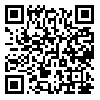Volume 11, Issue 4 (11-2023)
JRIA 2023, 11(4): 121-136 |
Back to browse issues page
Download citation:
BibTeX | RIS | EndNote | Medlars | ProCite | Reference Manager | RefWorks
Send citation to:



BibTeX | RIS | EndNote | Medlars | ProCite | Reference Manager | RefWorks
Send citation to:
mirshamsi M S, vafamehr M, jahan bakhsh H, barzegar Z. (2023). The assessment of daylight performance using indicators of Illuminance, Day light Factor and Penetration depth in the combined pattern of mosque- school- residential buildings, case study: Mansouriye Traditional Seminary in Shiraz. JRIA. 11(4), 121-136. doi:10.61186/jria.11.4.8
URL: http://jria.iust.ac.ir/article-1-1713-en.html
URL: http://jria.iust.ac.ir/article-1-1713-en.html
1- Department of Architecture, Mashhad Branch, Islamic Azad University, Mashhad, Iran
2- Department of Architecture, Mashhad Branch, Islamic Azad University, Mashhad, Iran/ Department of Architecture, Faculty of Architecture and Urban Planning, IUST, Tehran, Iran.
3- Department of Architecture, Mashhad Branch, Islamic Azad University, Mashhad, Iran/ Department of Art & Architecture Faculty of Engineering Payam Noor University, Tehran, Iran
2- Department of Architecture, Mashhad Branch, Islamic Azad University, Mashhad, Iran/ Department of Architecture, Faculty of Architecture and Urban Planning, IUST, Tehran, Iran.
3- Department of Architecture, Mashhad Branch, Islamic Azad University, Mashhad, Iran/ Department of Art & Architecture Faculty of Engineering Payam Noor University, Tehran, Iran
Abstract: (2340 Views)
In the noble verses of the Quran and the traditions of the Prophet Muhammad (pbuh) and the Imams, multiple references have been made to places of worship, education, and residence. On the other hand, religious texts have extensively discussed light and its concepts. Architecture has long been a manifestation of sublime human emotions and a platform for the realization of human excellence. It creates a perceptible space that leads individuals to contemplation. Therefore, this article focuses on the assessment of daylight in the combined pattern of mosque-school-residential buildings, in one of its exceptional case studies, the Mansouriye Traditional Seminary in Shiraz. Daylight was evaluated based on indicators of illuminance, daylight factor, and light penetration depth on the first day of 22 December from 8 AM to 5 PM. The data for each component was collected in the selected southeast direction of worship, educational, and residential spaces using measurement methods (lux meter device), numerical calculations (Olgy formula), and geometric calculations. The data was then analyzed using two quantitative comparative methods with the standard of LED and the Iranian Lighting Design Association, and a qualitative analysis method. The results indicate satisfactory utilization of daylight in the studied space within the functional time frame of Islamic-Iranian architecture. The illuminance intensity in the mosque does not meet the standard. However, this indicator ranges from 200 to 500 lux in the school and from 150 to 500 lux in the room, aligning with the specified standards. The daylight factor in the place of worship does not have the standard, while it ranges from 2 to 5 percent in the school and in the room until 11 AM remain within the standard.
Keywords: Mosque-school-residential buildings, Day Light, Illuminance, Day light Factor, light penetration depth, Shiraz
Type of Study: Research |
Subject:
Strategic and practical principals in Islamic architecture and urbanism
Received: 2023/10/21 | Accepted: 2024/03/4 | Published: 2024/03/4
Received: 2023/10/21 | Accepted: 2024/03/4 | Published: 2024/03/4
Send email to the article author
| Rights and permissions | |
 |
This work is licensed under a Creative Commons Attribution-NonCommercial 4.0 International License. |






